Ky çast i kapur në fotografi është një dritare drejt një universi krijues që nuk ndalet asnjëherë. Aty ku të tjerët shohin thjesht një ngjyrë apo një formë, Shefqet Avdush Emini sheh dhe na ofron një botë të tërë – një botë të ndërtuar nga ndjenja, kujtime, ëndrra dhe kujtesë kolektive. Në veprat e tij, asgjë nuk është sipërfaqësore; çdo vijë, çdo ngjyrë, çdo shtresë është një deklaratë e thellë shpirtërore dhe estetike.
Në këtë pikturë në proces, që mund të shihet si një simfoni e figurës njerëzore në ndërtim, artisti nuk kërkon të na japë një imazh të përfunduar, por na fton të jemi dëshmitarë të lindjes së një universi të brendshëm. Figura femërore që ngrihet nga telajo është një entitet në tranzicion – as plotësisht reale, as plotësisht abstrakte – ajo qëndron në një hapësirë të ndërmjetme, një terren ku identiteti, emocioni dhe shpirti ndërthuren me fuqinë transformuese të ngjyrës.
Ngjyra si gjuhë shpirtërore
Ngjyra, për Shefqetin, nuk është thjesht një element vizual, por një mjet meditativ. Bluja e thellë, që mbizotëron në këtë vepër, sjell ndjesinë e paqes së brendshme dhe reflektimit, por në të njëjtën kohë përçon edhe një formë të heshtur të dhimbjes ose mallëngjimit. Ajo është si deti që ruan në thellësi histori të pashprehura. E kuqja, si ngjyrë e shpirtit dhe e përplasjes së ndjenjave, krijon një tension emocional që futet thellë në ndërdijen e shikuesit. Ndërsa e verdha – simbol i dritës, shpirtit dhe kujtesës – ndërhyn për të dhënë kontrast dhe shpresë, për të krijuar dritare të mundshme shprese brenda një bote që luhatet mes kaosit dhe qetësisë.
Përdorimi i këtyre ngjyrave nuk është i rastësishëm. Ai reflekton një kod vizual që artisti ka ndërtuar ndër vite, ku çdo paletë është e lidhur me një ndjesi të caktuar, një përjetim emocional të përpunuar në heshtje, në studio apo në bashkëkrijim me hapësira ndërkombëtare.
Trupi i artistit si mjet krijimi
Është e pamundur të mos e vësh re se si trupi i artistit bëhet pjesë integrale e procesit krijues. Shefqeti nuk pikturon me dorë të ftohtë – çdo lëvizje e tij është një pjesë e ritualit të shenjtë të krijimit. Nga mënyra se si mban paletën dhe furçën, nga qëndrimi i trupit e deri te përqendrimi i thellë në fytyrë – gjithçka është dëshmi e një përjetimi total. Ai nuk e sheh artin si një profesion, por si një mënyrë të të jetuarit, një gjuhë që ia mundëson të komunikojë me botën pa fjalë, përmes emocioneve të ngjyrës dhe formës.
Në këtë mënyrë, trupi i tij në këtë foto është një instrument i ndjeshëm i një muzike të brendshme që vetëm ai mund ta dëgjojë dhe ta përkthejë në formë pamore. Është një formë meditimi aktiv, ku shpirti dhe materia shkrihen në një.
Piktura si arkiv emocional dhe filozofik
Shefqet Avdush Emini i përket atyre artistëve që nuk kërkojnë vetëm të impresionojnë syrin, por të tronditin zemrën dhe ndërgjegjen. Veprat e tij janë një kombinim i historisë personale dhe asaj kolektive. Ai mbart me vete kujtesën e popullit të tij, vuajtjet e luftës, eksodin dhe shpresën e një rilindjeje. Edhe kur nuk flet drejtpërdrejt për tragjedi, pikturat e tij mbajnë gjurmë të padukshme të dhimbjes njerëzore – jo si denoncim, por si kujtesë, si reflektim për atë që kemi qenë dhe për atë që ende jemi.
Figura në këtë pikturë mund të lexohet si metaforë e gruas universale – e nënës, motrës, mësueses, artistes – që mbart në fytyrën e saj të turbullt të gjitha përmasat e qenies. Ajo është njëkohësisht një simbol i ndjeshmërisë dhe i forcës, një kujtesë e thellë për rolin e pashprehshëm të femrës në mbijetesën e shoqërive njerëzore.
Ndikimi ndërkombëtar dhe gjuha universale e veprës së tij
Shefqet Avdush Emini ka qenë dhe mbetet një ambasador i kulturës përmes artit. Në çdo vend ku ka ekspozuar – nga Parisi në Kairo, nga Seuli në Bratislavë – veprat e tij kanë kaluar përtej barrierave gjuhësore dhe kulturore, duke komunikuar përmes një gjuhe të përbashkët njerëzore. Stili i tij është unik, por mesazhi është universal: njeriu si qenie ndjesore, e përhershme në kërkim të dritës, kuptimit dhe shpresës.
Në këtë kuptim, kjo pikturë e veçantë është një pjesë e mozaikut të madh të krijimtarisë së tij, ku çdo vepër është një fije drite që ndriçon rrugëtimin e përbashkët njerëzor.
ENGLISH
Shefqet Avdush Emini – The Inner World of Color and the Memory of the Human Soul
In this photograph, which captures an authentic moment of creation, we see the internationally renowned artist Shefqet Avdush Emini deeply immersed in the act of painting during an international symposium. Dressed simply and absorbed in the meditative silence of creation, he is surrounded by the vibrant atmosphere of an artistic laboratory, where the collective energy of creators can be felt—yet he remains fully immersed in his own inner world, in the depths of the emotion that color transmits to the canvas.
The figure taking shape at this moment is a woman—her portrait enveloped in shades of blue, interwoven with vivid tones of red, yellow, and white, blending together in a profound expressionist play. The painting bears the characteristic marks of Shefqet Avdush Emini’s style—an aesthetic developed over decades, fusing abstraction, spirituality, and figuration into a unique language that flows between reality and metaphor.
The woman’s face emerges like an icon from the depths of a collective memory—undefined in identity, yet vividly present in emotion. The dominant blue, often used in art history as a symbol of sorrow, silence, peace, and introspection, becomes in Emini’s hands a spiritual space where the figure ascends toward the light. The layers of color resemble wounds, but also serve as pathways to understanding the depth of human experience.
Red and yellow intervene as emotional signs, voices of a silent drama—perhaps love, perhaps war, perhaps memory. Invisible lines divide and unify the portrait with the background, creating a poetic tension between form and infinity. There is no clear boundary between body and space—everything is interconnected, just as for Shefqet the human is one with the universe, pain with hope, time with eternity.
In this work, Emini is not attempting to create a realistic portrait, but rather a symbol of the universal human. The woman we see in the painting could be a historical figure, an anonymous mother, a refugee, a muse, a survivor—but above all, she is a mirror of the artist’s inner self, and perhaps of our shared human interiority.
Shefqet Avdush Emini – Colors of the Soul in Motion: A Portrait of Art in Creation
In this vivid and inspiring photograph, artist Shefqet Avdush Emini appears at the height of his creative act, fully immersed in his artistic process. He is participating in an international symposium, one of many he has attended throughout decades of rich and intensive artistic activity. The surrounding atmosphere speaks of a space of collaboration and passion, where artists from around the world share their experiences, visions, and inspirations. In this context, Shefqet stands as a central figure—not only as a creator but also as a symbol of international dialogue through art.
The painting he is working on features a female figure, rendered in an expressionist manner with a deep color palette that includes intense blues, fiery reds, and vibrant yellows. Though not realistically portrayed, this figure evokes profound emotions and represents a human presence that transcends time and space. Through mixed techniques, layered pigments, and dynamic brushstrokes, Emini creates a sense of internal movement, as if the portrait is not just an image, but a soul in evolution.
This signature style is the result of a long and profound artistic journey spanning decades of dedicated work, exhibitions in over 30 countries, and an extraordinary commitment to painting as a medium for expressing inner truth. Shefqet Avdush Emini is one of the most significant representatives of contemporary abstract expressionism on the international stage, and his work is a synthesis of masterful technique and humanist philosophy.
The figure in his painting is not intended to represent a specific individual, but rather the archetype of the human being on a spiritual journey. The colors speak of mixed emotions—melancholy, strength, gentleness, rebellion, and hope—while the composition, built with courage and intensity, gives the figure an eternal dimension. The dominant blue conveys an introspective atmosphere, a profound calm, while the yellow and red highlights add tension and life.
In this special moment captured by the photograph, we see not only a painting in progress but also the artist himself as a medium of art. His body, his clothing, the tools around him—all become part of a silent performance where the only language is that of color and movement. His charismatic presence, with a focused face and hands that speak of experience, reveals an artist who does not see painting as a goal, but as a path toward the depths of human existence.
Shefqet is a devoted artist who has always looked beyond geographic and stylistic boundaries. His works have been featured in some of the most prestigious museums, galleries, and biennials across Europe, Asia, America, and Africa. They are not merely aesthetic displays, but also philosophical and political reflections on humanity, freedom, pain, war, and love.
This moment, captured in the photograph, stands as a testament to his life devoted to art. He is not simply a painter who creates works, but a human being who lives through art—a writer of emotions with a brush, a philosopher who speaks not with words, but with light and color. The painting he is creating here is more than a portrait—it is a soul in visual translation, a feeling being unveiled, a story that needs no words to reach the deepest parts of us.
Shefqet Avdush Emini – On the Path of Light and Color: The Philosophy of a Soul Becoming Form
This captured moment in the photograph is a window into a creative universe that never rests. Where others may see mere color or form, Shefqet Avdush Emini sees—and offers us—an entire world: one built from emotion, memory, dreams, and collective consciousness. In his works, nothing is superficial; every line, every hue, every layer is a profound spiritual and aesthetic statement.
In this painting in progress, which may be viewed as a symphony of the human figure under construction, the artist does not strive to offer a finalized image but invites us to witness the birth of an inner universe. The female figure emerging from the canvas is an entity in transition—not fully real, not entirely abstract—existing in an in-between space, where identity, emotion, and soul merge with the transformative power of color.
Color as a Spiritual Language
Color, for Shefqet, is not merely a visual element but a meditative tool. The deep blue that dominates this piece evokes a sense of inner peace and contemplation, while simultaneously conveying a quiet form of grief or longing. It resembles the sea, which holds unspoken histories in its depths. The red, symbolizing soul and emotional tension, creates a powerful emotional resonance that taps into the viewer’s subconscious. Meanwhile, yellow—light, memory, and spirit—offers contrast and hope, opening windows of possibility within a world that wavers between chaos and serenity.
His use of color is anything but accidental. It reflects a visual code he has developed over the years, where each palette is linked to a specific feeling, an emotional experience shaped in silence, either in his studio or in collaborative international spaces.
The Artist’s Body as a Creative Instrument
One cannot help but notice how the artist’s body becomes an integral part of the creative process. Shefqet does not paint with a detached hand—every movement is part of a sacred ritual of creation. From the way he holds the palette and brush, to the posture of his body and the deep concentration on his face—everything bears witness to total immersion. He does not perceive art as a profession, but as a way of being, a language through which he can speak to the world without words, through the emotions of color and form.
In this way, his physical presence in the image is an instrument attuned to an inner music only he can hear, and which he translates into visual form. It is a kind of active meditation, where spirit and matter blend into one.
Painting as Emotional and Philosophical Archive
Shefqet Avdush Emini belongs to those rare artists who do not aim to merely impress the eye but to stir the heart and conscience. His works are a convergence of personal and collective history. He carries with him the memory of his people, the pain of war, exile, and the hope for rebirth. Even when his paintings do not speak directly of tragedy, they carry invisible traces of human suffering—not as denunciation, but as remembrance, as reflection on who we have been and who we still are.
The figure in this painting can be read as a metaphor for the universal woman—mother, sister, teacher, artist—whose blurred face embodies all dimensions of being. She is at once a symbol of sensitivity and strength, a silent reminder of the unspoken role of women in the survival of human societies.
International Influence and the Universal Language of His Art
Shefqet Avdush Emini has been and continues to be an ambassador of culture through art. In every country where he has exhibited—from Paris to Cairo, from Seoul to Bratislava—his works transcend linguistic and cultural boundaries, speaking through a shared human language. His style is unique, yet his message is universal: the human being as a sensitive being, forever in search of light, meaning, and hope.
In this sense, this particular painting is a piece of the larger mosaic of his creativity, where each work is a thread of light illuminating the collective human journey.
DUTCH
Shefqet Avdush Emini – De Innerlijke Wereld van Kleur en de Herinnering van de Menselijke Ziel
In deze foto, die een authentiek creatief moment vastlegt, zien we de internationaal gerenommeerde kunstenaar Shefqet Avdush Emini diep geconcentreerd aan het schilderen tijdens een internationaal symposium. Eenvoudig gekleed en volledig ondergedompeld in de meditatieve stilte van het creatieve proces, bevindt hij zich in een levendige artistieke omgeving, waar de collectieve energie van kunstenaars voelbaar is. Toch blijft hij volledig gefocust op zijn innerlijke wereld, in de diepten van het gevoel dat kleur overbrengt op het doek.Het beeld dat op dit moment vorm krijgt, is dat van een vrouw—haar portret omhuld door tinten blauw, verweven met levendige tonen van rood, geel en wit, die samenkomen in een diep expressionistisch spel. Het schilderij draagt de kenmerkende stijl van Shefqet Avdush Emini—een esthetiek ontwikkeld over decennia, die abstractie, spiritualiteit en figuratie samenvoegt tot een unieke taal die tussen realiteit en metafoor stroomt.Het gezicht van de vrouw komt naar voren als een icoon uit de diepten van een collectief geheugen—onbepaald in identiteit, maar levendig aanwezig in emotie. Het dominante blauw, vaak gebruikt in de kunstgeschiedenis als symbool voor verdriet, stilte, vrede en introspectie, wordt in Eminis handen een spirituele ruimte waarin de figuur opstijgt naar het licht. De lagen kleur lijken op wonden, maar dienen ook als paden om de diepte van de menselijke ervaring te begrijpen.Rood en geel treden op als emotionele tekens, stemmen van een stille drama—misschien liefde, misschien oorlog, misschien herinnering. Onzichtbare lijnen verdelen en verenigen het portret met de achtergrond, waardoor een poëtische spanning ontstaat tussen vorm en oneindigheid. Er is geen duidelijke grens tussen lichaam en ruimte—alles is met elkaar verbonden, net zoals voor Shefqet de mens één is met het universum, pijn met hoop, tijd met eeuwigheid.In dit werk probeert Emini geen realistisch portret te creëren, maar eerder een symbool van de universele mens. De vrouw die we in het schilderij zien, kan een historische figuur zijn, een anonieme moeder, een vluchteling, een muze, een overlevende—maar bovenal is zij een spiegel van het innerlijke zelf van de kunstenaar, en wellicht van onze gedeelde menselijke innerlijkheid.
Shefqet Avdush Emini – Kleuren van de Ziel in Beweging: Een Portret van Kunst in Creatie
In deze levendige en inspirerende foto verschijnt kunstenaar Shefqet Avdush Emini op het hoogtepunt van zijn creatieve daad, volledig ondergedompeld in zijn artistieke proces. Hij neemt deel aan een internationaal symposium, een van de vele waaraan hij heeft deelgenomen gedurende decennia van rijke en intensieve artistieke activiteit. De omringende sfeer spreekt van een ruimte van samenwerking en passie, waar kunstenaars van over de hele wereld hun ervaringen, visies en inspiratie delen. In deze context staat Shefqet als een centrale figuur—niet alleen als schepper, maar ook als symbool van internationale dialoog door middel van kunst. Het schilderij waaraan hij werkt, toont een vrouwelijke figuur, weergegeven in een expressionistische stijl met een diep kleurenpalet dat intense blauwen, vurige roden en levendige gelen omvat. Hoewel niet realistisch afgebeeld, roept deze figuur diepe emoties op en vertegenwoordigt een menselijke aanwezigheid die tijd en ruimte overstijgt. Door gemengde technieken, gelaagde pigmenten en dynamische penseelstreken creëert Emini een gevoel van innerlijke beweging, alsof het portret niet slechts een beeld is, maar een ziel in evolutie.Deze kenmerkende stijl is het resultaat van een lange en diepgaande artistieke reis die decennia van toegewijd werk, tentoonstellingen in meer dan 30 landen en een buitengewone toewijding aan schilderen als medium voor het uitdrukken van innerlijke waarheid omvat. Shefqet Avdush Emini is een van de meest significante vertegenwoordigers van het hedendaagse abstracte expressionisme op het internationale toneel, en zijn werk is een synthese van meesterlijke techniek en humanistische filosofie.De figuur in zijn schilderij is niet bedoeld om een specifiek individu te vertegenwoordigen, maar eerder het archetype van de menselijke geest op een spirituele reis. De kleuren spreken van gemengde emoties—melancholie, kracht, zachtheid, rebellie en hoop—terwijl de compositie, opgebouwd met moed en intensiteit, de figuur een eeuwige dimensie geeft. Het dominante blauw straalt een introspectieve sfeer uit, een diepe rust, terwijl de gele en rode accenten spanning en leven toevoegen.In dit bijzondere moment, vastgelegd door de foto, zien we niet alleen een schilderij in wording, maar ook de kunstenaar zelf als medium van kunst. Zijn lichaam, zijn kleding, de gereedschappen om hem heen—alles wordt onderdeel van een stille performance waarin de enige taal die van kleur en beweging is. Zijn charismatische aanwezigheid, met een geconcentreerd gezicht en handen die spreken van ervaring, onthult een kunstenaar die schilderen niet ziet als een doel, maar als een pad naar de diepten van het menselijk bestaan.Shefqet is een toegewijde kunstenaar die altijd verder heeft gekeken dan geografische en stilistische grenzen. Zijn werken zijn te zien geweest in enkele van de meest prestigieuze musea, galerieën en biënnales in Europa, Azië, Amerika en Afrika. Ze zijn niet slechts esthetische vertoningen, maar ook filosofische en politieke reflecties op de mensheid, vrijheid, pijn, oorlog en liefde.Dit moment, vastgelegd in de foto, staat als een getuigenis van zijn leven gewijd aan kunst. Hij is niet simpelweg een schilder die werken creëert, maar een mens die leeft door kunst—een schrijver van emoties met een penseel, een filosoof die niet spreekt met woorden, maar met licht en kleur. Het schilderij dat hij hier creëert, is meer dan een portret—het is een ziel in visuele vertaling, een gevoel dat wordt onthuld, een verhaal dat geen woorden nodig heeft om de diepste delen van ons te bereiken.
Shefqet Avdush Emini – Op het pad van licht en kleur: de filosofie van een ziel die vorm wordt
Dit vastgelegde moment op de foto is een venster naar een creatief universum dat nooit rust. Waar anderen slechts kleur of vorm zien, ziet Shefqet Avdush Emini – en biedt ons – een hele wereld: opgebouwd uit emotie, herinnering, dromen en collectief bewustzijn. In zijn werk is niets oppervlakkig; elke lijn, elke kleur, elke laag is een diepgaande spirituele en esthetische verklaring.In dit schilderij-in-wording, dat gezien kan worden als een symfonie van het menselijke figuur in opbouw, probeert de kunstenaar niet een voltooid beeld aan te bieden, maar nodigt hij ons uit getuige te zijn van de geboorte van een innerlijk universum. De vrouwelijke figuur die uit het doek tevoorschijn komt, is een entiteit in transitie – niet volledig realistisch, noch geheel abstract – bestaand in een tussengebied waar identiteit, emotie en ziel samensmelten met de transformerende kracht van kleur.
Kleur als spirituele taal
Kleur is voor Shefqet niet enkel een visueel element, maar een meditatief instrument. Het diepe blauw dat dit werk domineert, roept een gevoel van innerlijke rust en contemplatie op, terwijl het tegelijkertijd een stille vorm van verdriet of verlangen uitdrukt. Het lijkt op de zee, die ongezegde geschiedenissen in haar diepte verbergt. Het rood, dat ziel en emotionele spanning symboliseert, creëert een krachtige resonantie die het onderbewustzijn van de toeschouwer aanspreekt. En het geel – licht, herinnering, geest – biedt contrast en hoop, en opent vensters van mogelijkheid binnen een wereld die balanceert tussen chaos en sereniteit.Zijn kleurgebruik is allesbehalve toevallig. Het weerspiegelt een visuele code die hij door de jaren heen heeft ontwikkeld, waarbij elk palet verbonden is aan een specifieke emotie – een innerlijke ervaring gevormd in stilte, in zijn atelier of binnen internationale creatieve ontmoetingen.
Het lichaam van de kunstenaar als creatief instrument
Men kan niet anders dan opmerken hoe het lichaam van de kunstenaar zelf een integraal onderdeel wordt van het scheppingsproces. Shefqet schildert niet met een afstandelijke hand – elke beweging is onderdeel van een heilig ritueel van creatie. Van de manier waarop hij het palet en de penseel vasthoudt, tot de houding van zijn lichaam en de diepe concentratie op zijn gezicht – alles getuigt van totale overgave. Voor hem is kunst geen beroep, maar een manier van bestaan, een taal waarmee hij zonder woorden tot de wereld spreekt – via de emoties van kleur en vorm.Zijn fysieke aanwezigheid in dit beeld is een instrument dat is afgestemd op een innerlijke muziek die alleen hij hoort en die hij vertaalt naar visuele vormen. Het is een vorm van actieve meditatie, waarin geest en materie samenvloeien tot één.
Schilderkunst als emotioneel en filosofisch archief
Shefqet Avdush Emini behoort tot die zeldzame kunstenaars die niet enkel willen imponeren met het oog, maar het hart en geweten willen beroeren. Zijn werken zijn een samenvloeiing van persoonlijke en collectieve geschiedenis. Hij draagt de herinnering van zijn volk, de pijn van oorlog, ballingschap en de hoop op wedergeboorte. Zelfs wanneer zijn schilderijen niet direct over tragedie spreken, dragen ze onzichtbare sporen van menselijk lijden – niet als aanklacht, maar als herinnering, als reflectie op wie we zijn geweest en wie we nog steeds zijn.De figuur in dit schilderij kan gelezen worden als een metafoor voor de universele vrouw – moeder, zuster, lerares, kunstenaar – wier vervaagde gezicht alle dimensies van het bestaan belichaamt. Zij is tegelijk een symbool van gevoeligheid en kracht, een stille herinnering aan de onuitgesproken rol van vrouwen in het voortbestaan van menselijke samenlevingen.
Internationale invloed en de universele taal van zijn kunst
Shefqet Avdush Emini is en blijft een culturele ambassadeur via de kunst. In elk land waar hij heeft geëxposeerd – van Parijs tot Caïro, van Seoel tot Bratislava – overstijgen zijn werken de grenzen van taal en cultuur, en spreken ze via een gedeelde menselijke taal. Zijn stijl is uniek, maar zijn boodschap is universeel: de mens als een gevoelig wezen, altijd op zoek naar licht, betekenis en hoop.In die zin is dit specifieke schilderij een stukje van het grotere mozaïek van zijn creativiteit, waarin elk werk een draad van licht is die de collectieve menselijke reis verlicht.

.jpg)







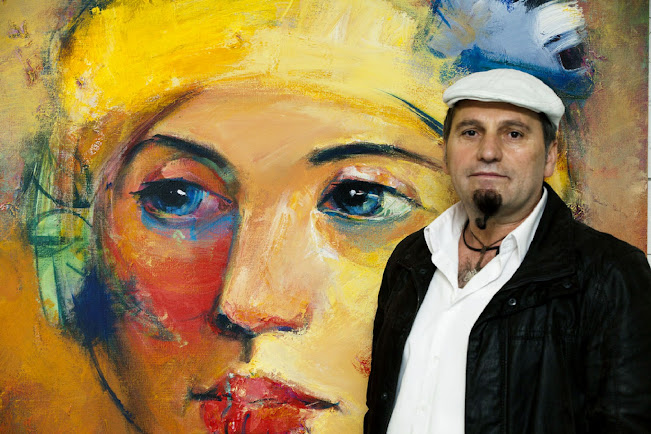






.jpg)

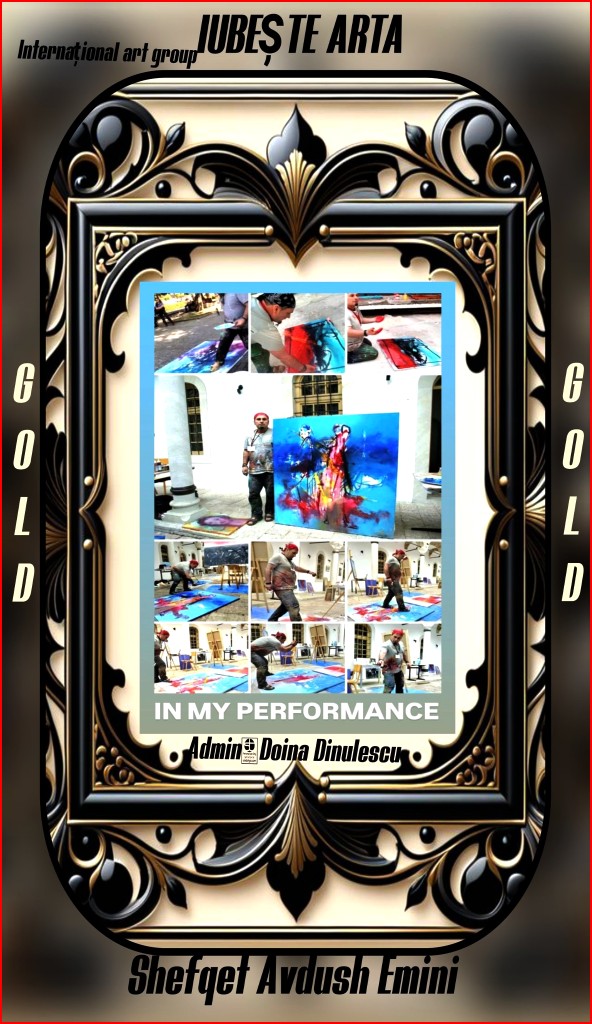








































.jpg)







.jpg)





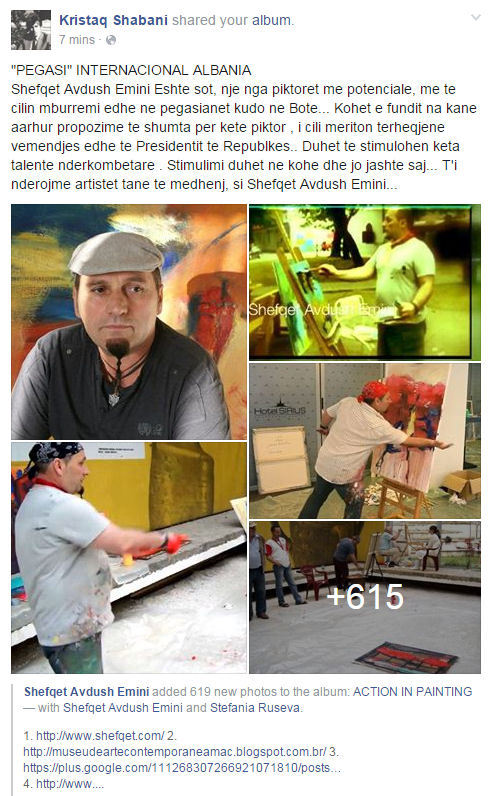







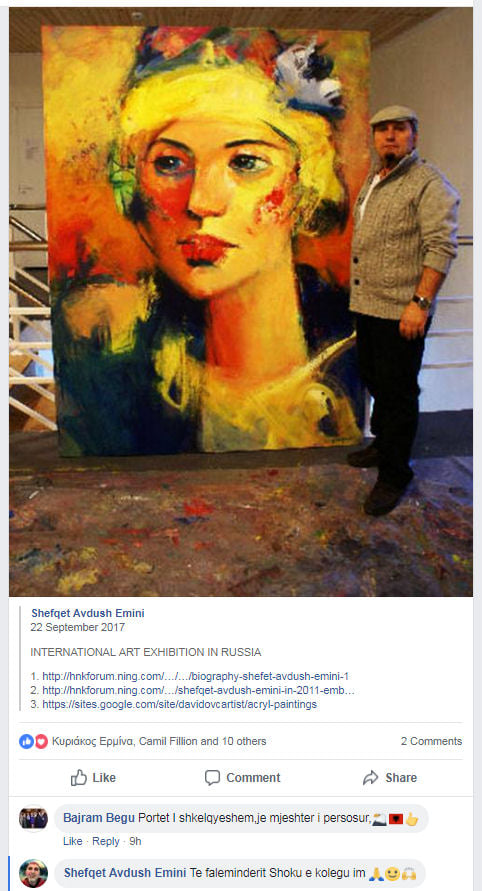



.png)












.png)


.jpg)

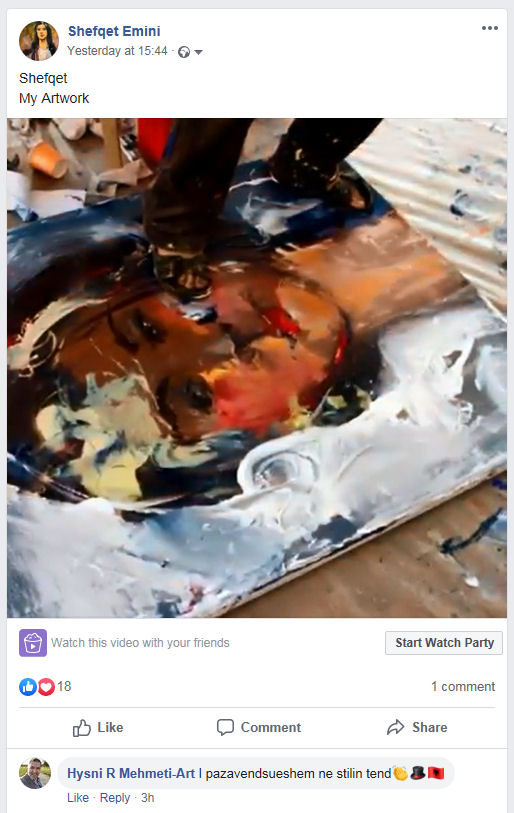

.jpg)
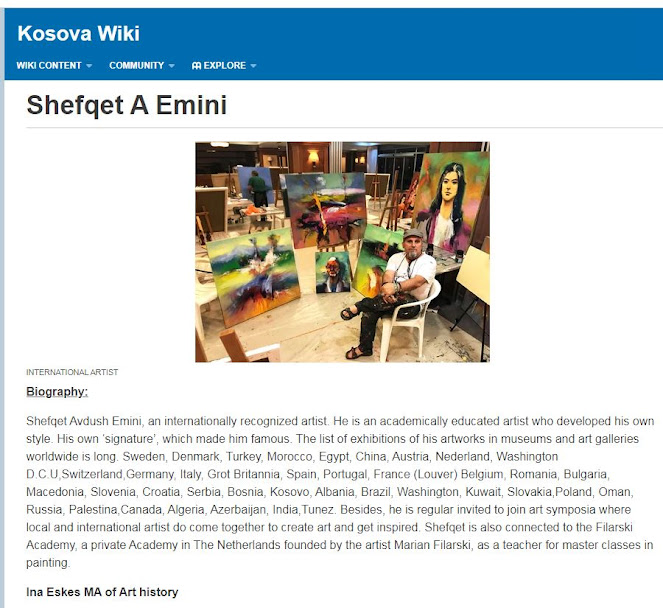

.JPG)



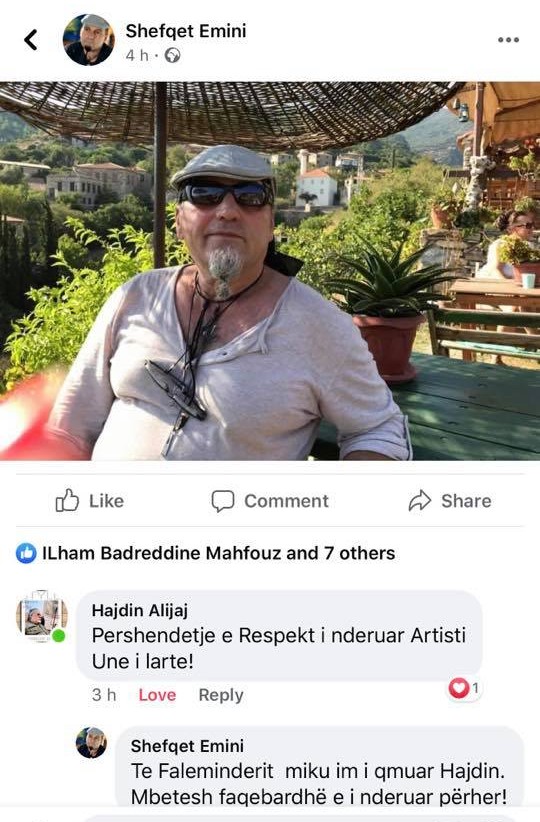




























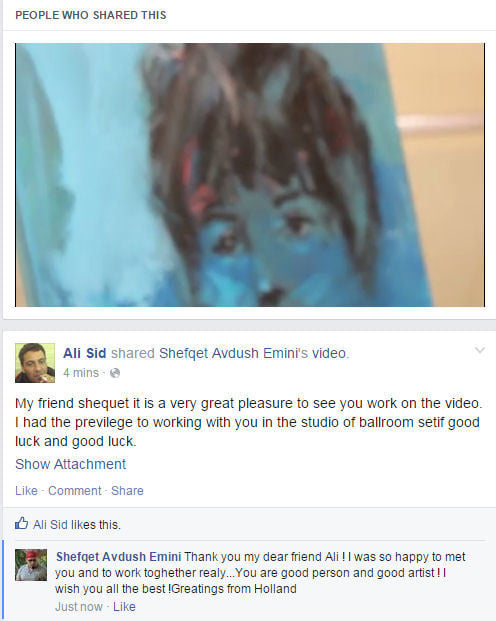




.jpg)



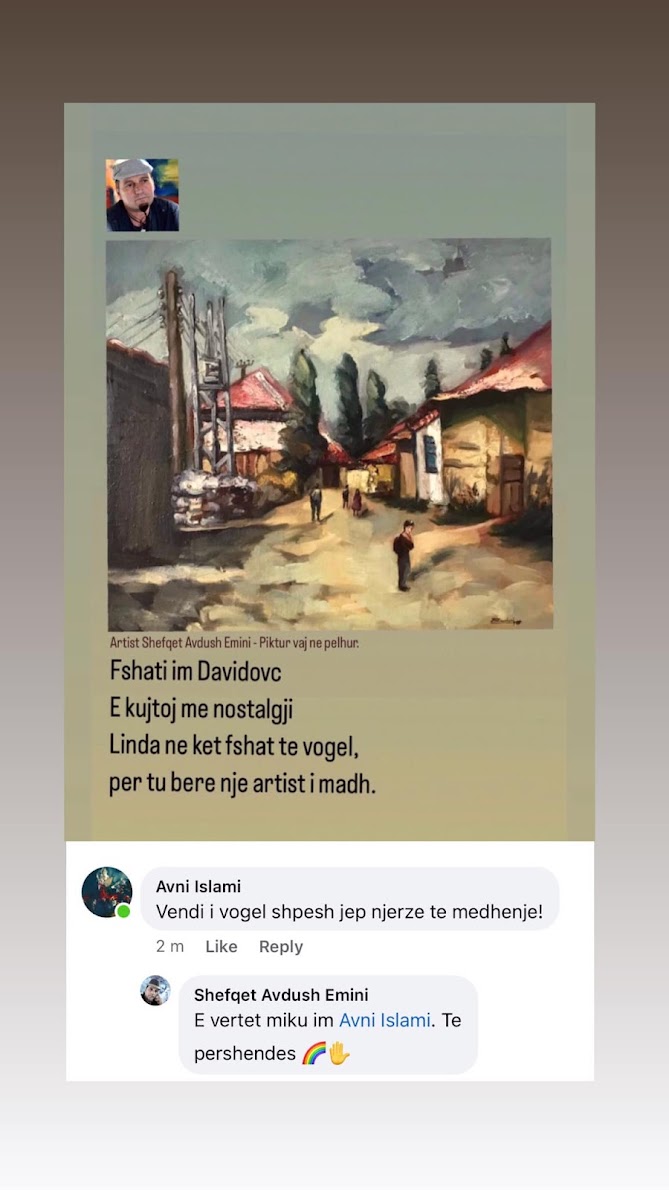




















.jpg)




.jpg?profile=RESIZE_710x)







.jpg?profile=RESIZE_710x)

















.png?profile=RESIZE_710x)









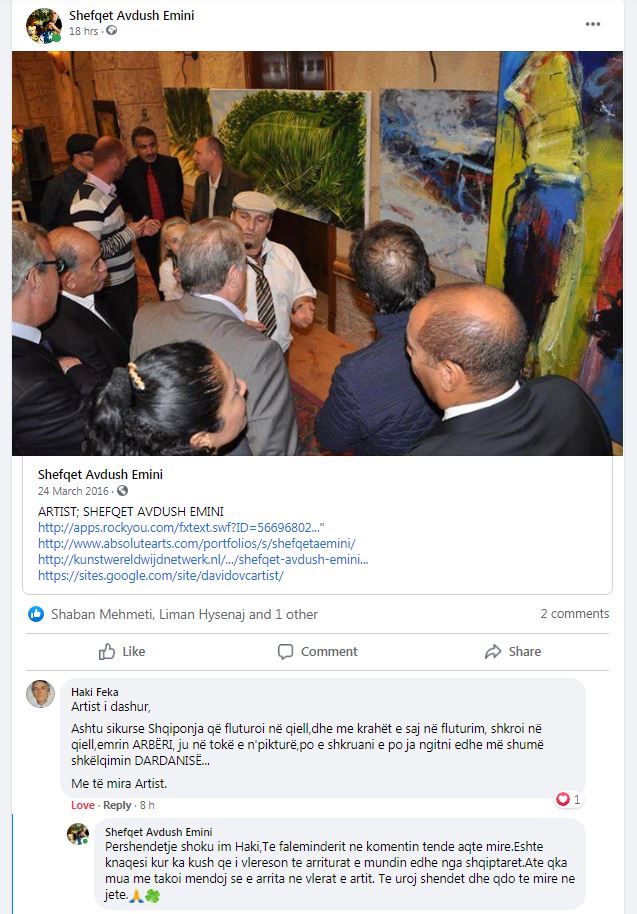

.png?profile=RESIZE_710x)


.jpg?profile=RESIZE_710x)



.jpg?profile=RESIZE_710x)




























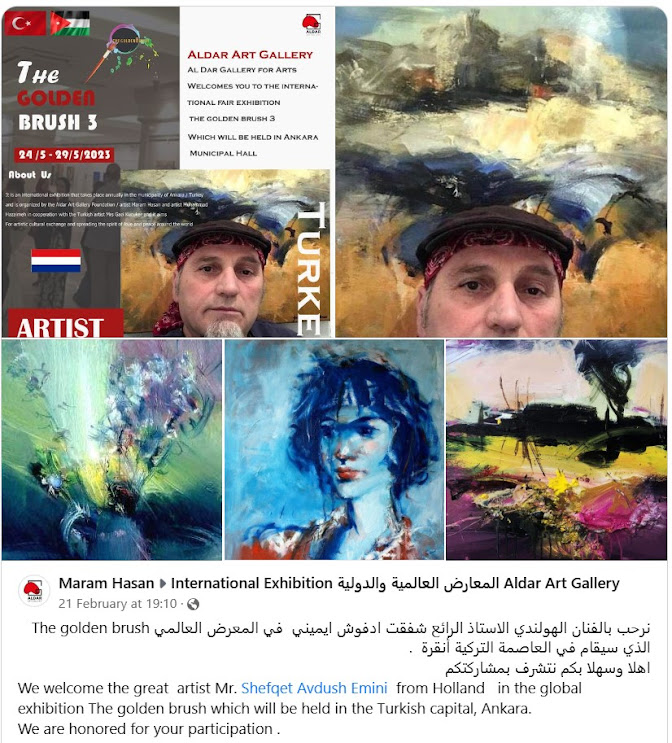


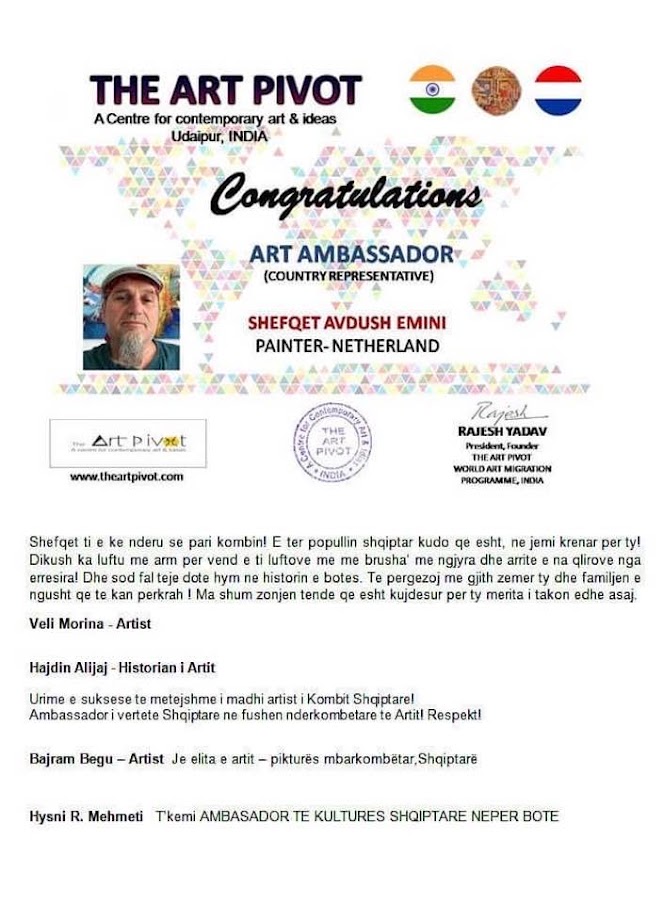


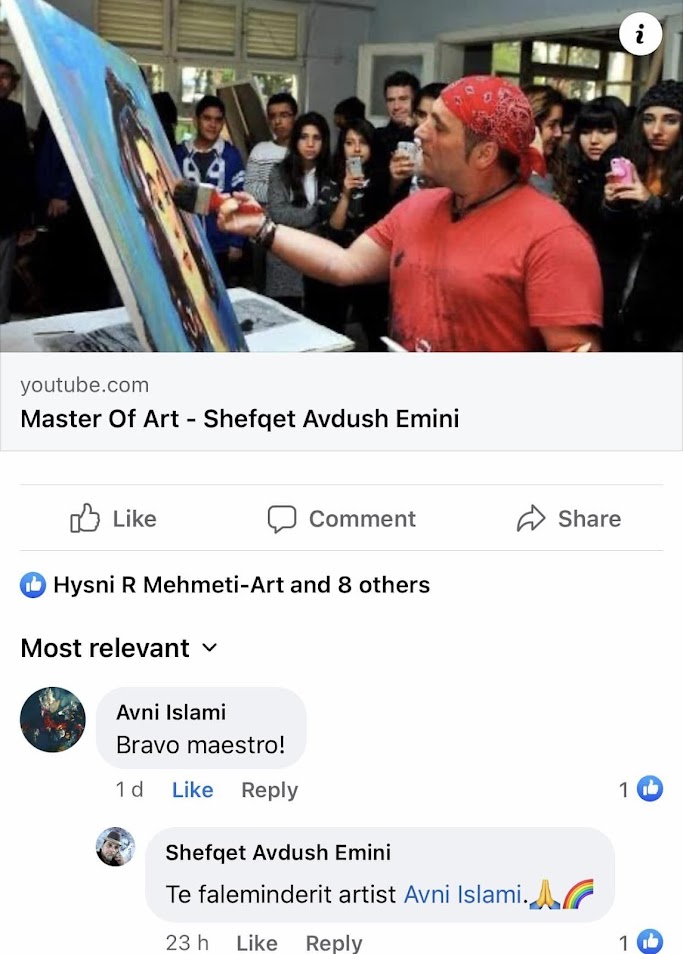


.jpg?profile=RESIZE_710x)














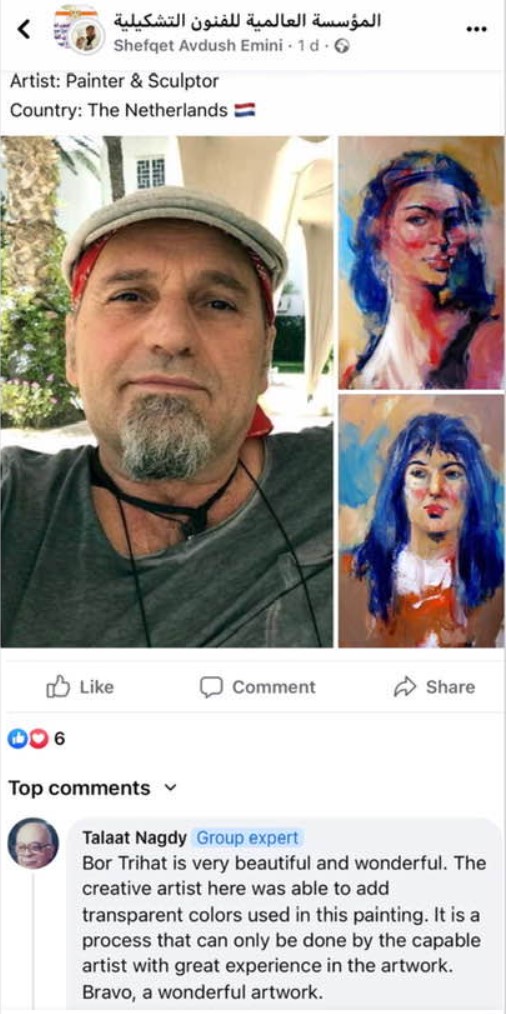








.jpg?profile=RESIZE_710x)



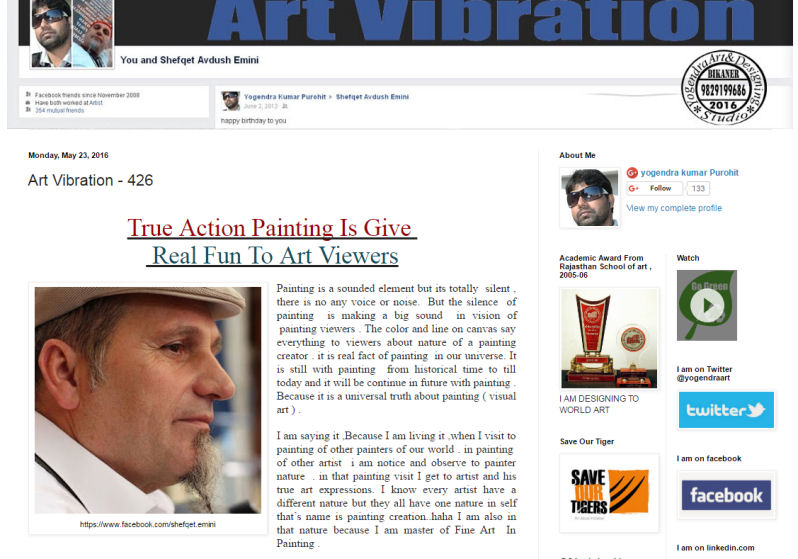
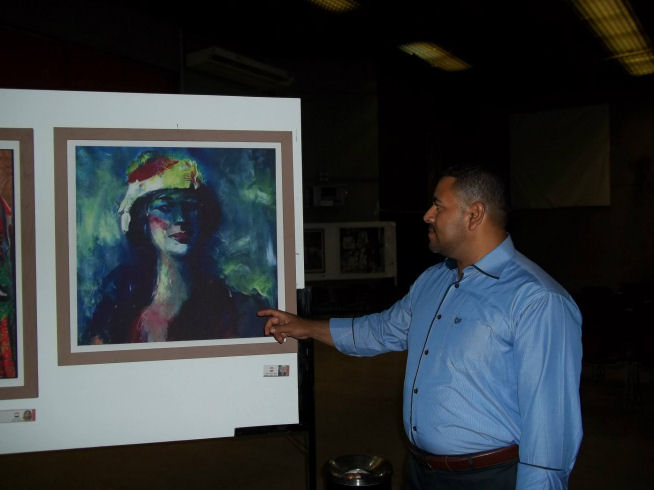
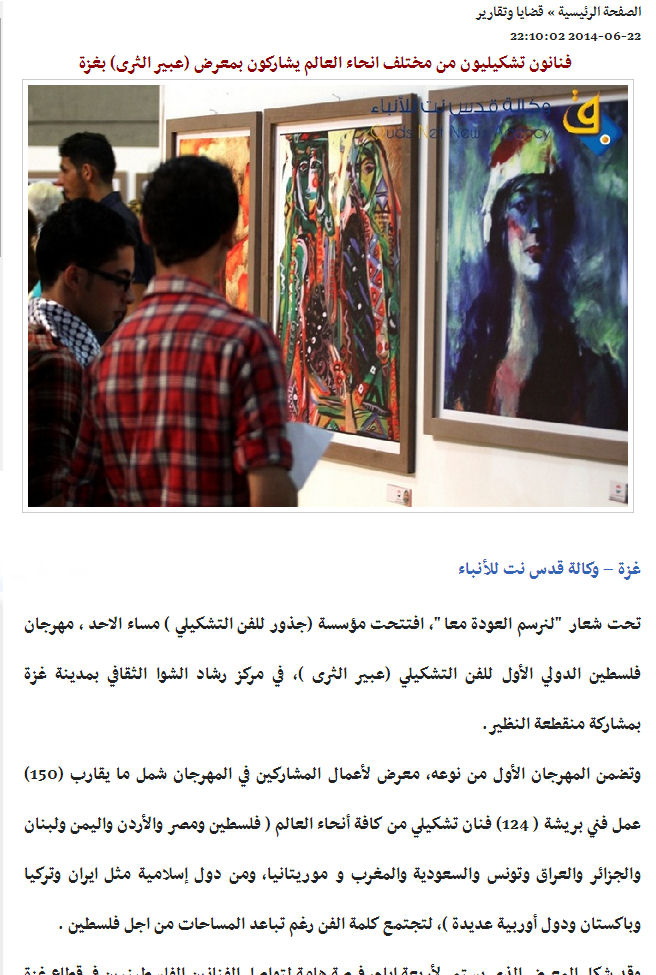
.jpg?profile=RESIZE_710x)
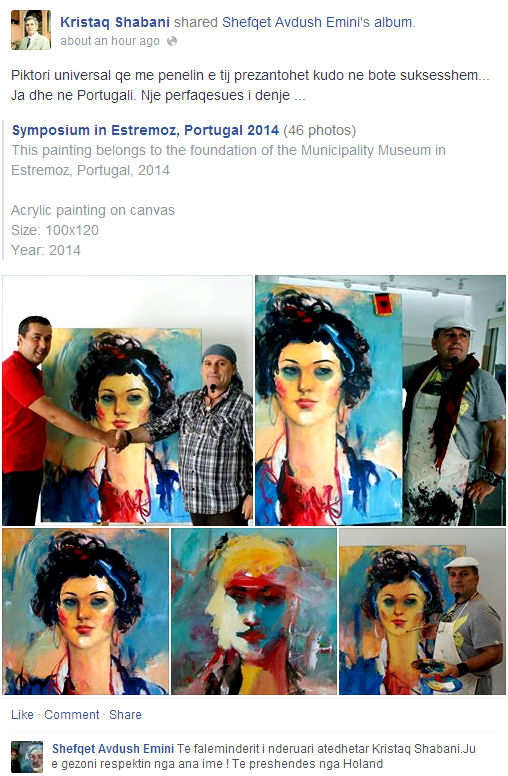
.jpg?profile=RESIZE_710x)
.jpg?profile=RESIZE_710x)
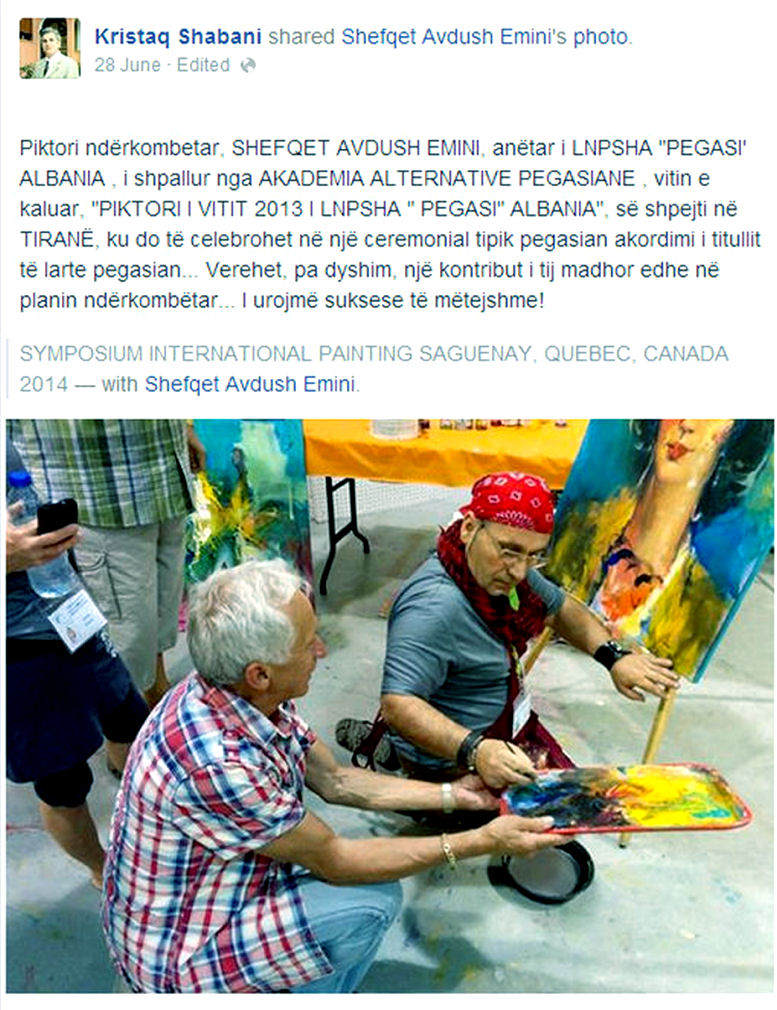

No comments:
Post a Comment